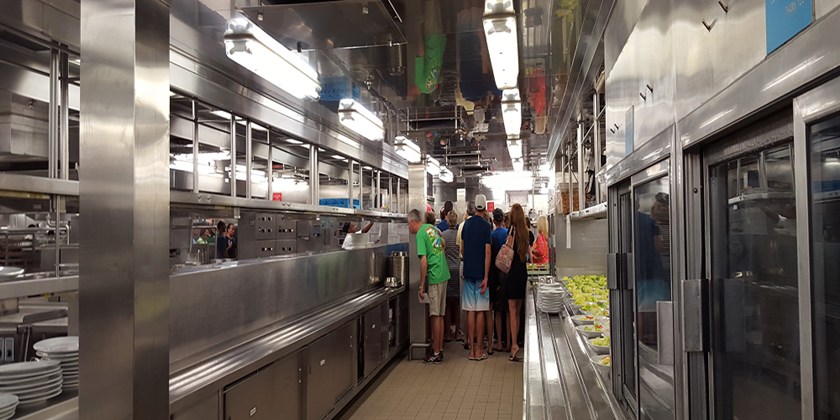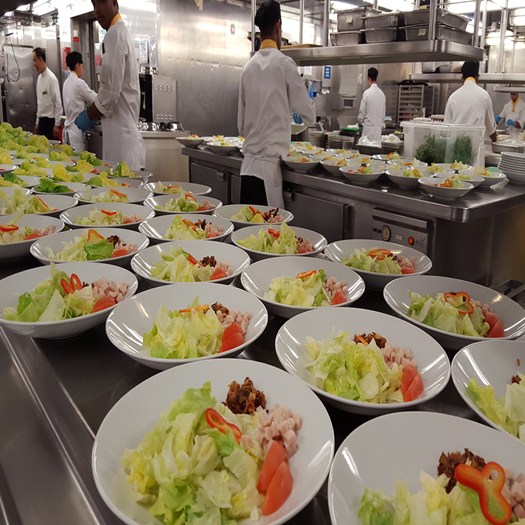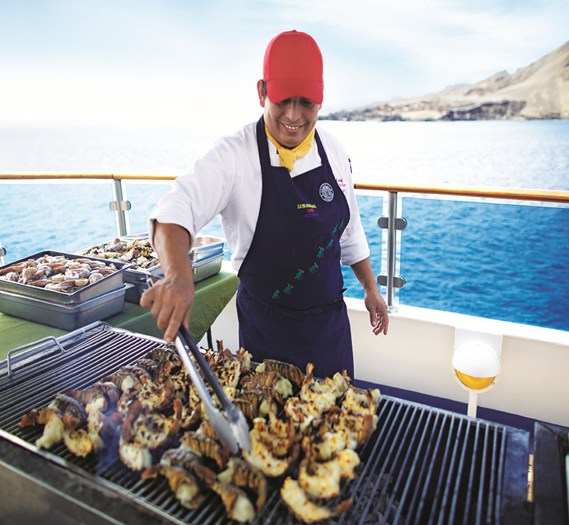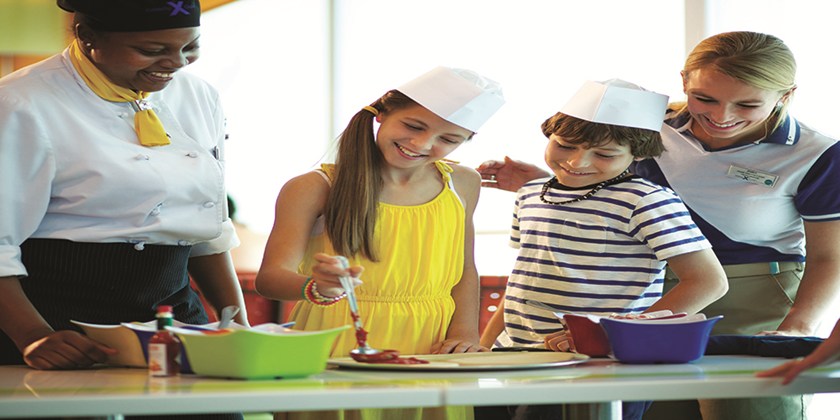ABOARD THE CELEBRITY CONSTELLATION - Behind the galley doors, chefs meticulously garnish mint on a line of desserts while kitchen staff remove the wilted leaves from salad crates and run towers of steaming entrees into the dining hall.
Feeding 2,500 passengers for one week in the middle of a sea requires a symphony of logistics.
So how do cruise lines pull it all off and cater to the varying appetites of thousands of guests at the same time?
Who better to ask than Celebrity Cruises’ Chef Cornelius Gallagher, who is associate vice president of Food and Beverage Operations for the line, and Chef Stephen Adelle-Jondeau, Celebrity’s senior fleet executive chef.
According to both chefs, who oversee menu development and implementation across Celebrity’s 10 ships, the key ingredient is creativity, a seamless on-board preparation system and more than 200 galley staff that can execute the plan to perfection.
Provisioning the ship for a journey begins at 8 a.m. at the port of arrival. Approximately 365 pallets are loaded for a week-long voyage, more than 220 are dedicated to food stock.
“The executive chef and the provision master will inspect all of the perishables to ensure quality and flavour,” says Gallagher. Without approval, an item cannot be loaded onto the ship. Rejected products are exchanged by the supplier or recovered at the next port of call.
The potential for emergencies mid-sea is considered when provisioning. Celebrity ships always account for three additional days’ worth of proteins — a seven-night itinerary will carry enough food for 10 nights.
For a week-long voyage, more than 11,300 kilograms of beef, 6,830 kilograms of eggs and 18,000 bottles of wine are stocked.

Above: The galley on the Celebrity Constellation is operating room clean.
“There’s nothing like a little indulgence while on vacation,” says Gallagher.
Consistently, the cookie and ice cream stock depletes the quickest, according to the chefs.
Cruises with duration of 12 nights or more will restock at a port of call. Fruit, lettuce and other produce need to be replenished mid-journey due to their perishable nature.
Nearly 5,800 kilograms of flour is used in one week because 95 per cent of the breads consumed are freshly baked onboard, with the exception of gluten-free bread, hamburger buns and hot dog rolls.
In a world of veganism, lactose intolerance, gluten sensitivity and increasing dietary restrictions, kitchens must adapt to the growing demands. Prior to guests’ arrival, a manifest is created specifying food restrictions. Chefs meet with the guests to review their dietary requirements and execute a plan. Low-fat, low-sodium and low-cholesterol options have been created with dietary specialists. Kosher dining and baby food is available to guests if it is requested six weeks before the departure date. As a cautionary measure and to avoid cross-contamination, special request meals are prepared in a separate area of the galley.
Demographic reports are used to cater to the diet trends of travellers from varying continents. Up to three months in advance, the shipboard team creates a report that includes guests’ age and nationality. The data allows the food and beverage team to better identify food preferences and eating habits. For instance, North Americans consume more chicken, Europeans tend to eat more seafood and Australians prefer beef and lamb. Based on the findings, the ship’s stock and food offerings will be adjusted accordingly.
Chinese and Indian dishes are a permanent offering at the lunch and dinner buffets. These two cuisines are among the guests’ favourites.
“Indian fare is known to be a comfort food for U.K. guests,” says Gallagher. Comfort food and vacation go hand-in-hand.
Research is needed to determine the menu; the goal is to keep food selections consistent year round. The seasons do not significantly affect menu options. Adelle-Jondeau says the growing seasons have extended over the past decade. Fresh fruit and vegetable availability no longer influence the menu.


Left: An army of chefs prepare a boat load of food every day. Right: Sometimes the chefs come top sicde to prepare some barbecue specialties.
Food waste on the consumers’ end is a given in all-inclusive set ups. It is common to see plates of unfinished food being cleared to accommodate space for a second or third round but Gallagher states only 2 per cent of the food stock is wasted. Taking into account that more than 11,000 kilograms of beef and 23,000 kilograms of fruit are stocked for a seven-night journey, 2 per cent is a considerable amount.
Re-inventing cooked ingredients can be a common practice in all-inclusive settings to reduce food waste. However, this is not the case in Celebrity kitchens as the galley staff uphold strict food regulations. Prepared foods have a maximum four-hour limit once cooked. Whether the food is placed on the line or stored in the kitchen, remaining food with a cooked life greater than four hours must be discarded.
But how can food waste be minimized in a set-up intended for vacationer indulgence? The use of metrics and historical data aids is decreasing food loss. Data from previous voyages allows for a more accurate estimate of how much food is required for the duration of the cruise and Gallagher says a small-batch cooking approach is used.
In the a-la-carte setting, chefs can predict the count of entrées to produce and determine which ingredients are needed. Tailored refrigeration and storage systems are used to suit the needs of specific food and beverage products. The refrigeration systems are closely monitored to control the temperatures to best preserve ingredients.
More than 230 employees are staffed in the galley on a ship carrying up to 2,800 travellers. The staff is organized by skill set and experience. Guest flow, disembarkment and other business needs determine staff schedules; the number of chefs on shift correlates with the number of guests on board.

Above: Kids are enouyraged to get into their chef aprons as well.
Strategizing the galley operations for 10 ships serving tens of thousands of guests combined can be trying. Both Gallagher and Adelle-Jondeau agree the largest challenge is working with food and beverage suppliers. Specifically, the suppliers who fail to meet provision timelines. Stock replacements have to be coordinated for the next port of call, and in some cases, the ingredients may not be acquired until after a few days at sea.
The next time you are cruising, consider the journey behind each component on your plate. Where was the ingredient sourced? How did it reach a grill in the middle of the Caribbean Sea?
And most importantly, when will it find its way to the final destination point: your stomach.
About the Author
Journalist, matchmaker and food traveller. Chelsea has a Bachelor of Journalism from Ryerson University where she was trained in print, radio and television reporting. She travels with only one goal in mind: to conquer each city's top rated restaurants in as little time as possible. If this means six meals in one day, she will have her stretchy pants ready to go. Chelsea has written for various publications focusing on food, spa, lifestyle, healthcare and science. When she is not writing or setting up dates, Chelsea spends her time with her two dogs, parrot and guinea pigs.